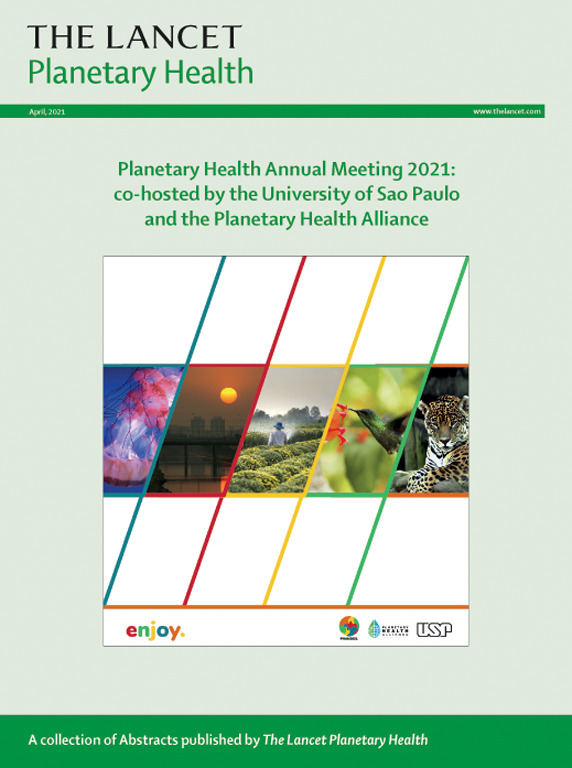Assessment of heatwave impacts on child feeding practices across 36 low-income and middle-income countries: a cross-sectional analysis
IF 21.6
1区 医学
Q1 ENVIRONMENTAL SCIENCES
引用次数: 0
Abstract
Background
Optimal feeding practices during the first 2 years of life are vital for child survival and growth. Current nutrition programmes in low-income and middle-income countries focus primarily on long-term dietary improvement, overlooking the acute challenges that heatwaves present to daily feeding practices in already nutritionally vulnerable populations.
Methods
By using the Demographic and Health Surveys data, we analysed data from the youngest child aged 6–23 months (including both infants aged 6–11 months and young children aged 12–23 months) in 293 137 households across 36 low-income and middle-income countries from 2000 to 2019. Our data came from mothers’ 24-h dietary recall interviews about what foods they fed their youngest child on the previous day and night. Child feeding indicators included minimum dietary diversity (MDD), minimum meal frequency (MMF), and minimum acceptable diet (MAD), following WHO standards. Heatwave exposure was defined using location-specific temperature thresholds (92·5th, 95th, and 97·5th percentiles) with different duration criteria (≥2 or ≥3 consecutive days). Mixed-effects logistic regression models with distributed lag model frameworks were adopted to examine the cumulative effects of heatwaves over 14 days, adjusting for potential confounders.
Findings
Heatwaves significantly disrupted feeding practices among children aged 6–23 months, with the strongest effects observed on the risk of not achieving MDD (odds ratio [OR] for not meeting MDD: 6·19 [95% CI 5·46–7·16] for 3-day heatwaves at 95th percentile threshold). More severe heatwaves additionally compromised the likelihood of achieving adequate meal frequency (OR for not meeting MMF: 2·78 [2·36–3·37] at 97·5th percentile), ultimately affecting children's ability to receive a minimum acceptable diet (OR for not meeting MAD: 4·66 [3·60–6·62]). These effects persisted up to 2 weeks post-exposure and showed strong negative impacts on consumption of nutrient-rich foods (OR 5·82 [4·44–7·65] for vegetables and vitamin A-rich fruits). Heightened vulnerability to inadequate feeding practices was observed in rural areas, low-income households, families with multiple young children, and those lacking cooling infrastructure (refrigerator or air conditioning), with ORs consistently higher than in their counterpart groups.
Interpretation
Our findings reveal that heatwaves rapidly disrupt child feeding practices, and these disruptions continue for up to 2 weeks. This evidence calls for urgent integration of short-term heat adaptation strategies within existing long-term nutrition programmes, particularly for access to nutrient-rich foods. Improving access to basic cooling facilities, especially in vulnerable communities, is vital for safeguarding child nutrition as global temperatures rise.
Funding
None.
评估36个低收入和中等收入国家热浪对儿童喂养做法的影响:横断面分析。
背景:生命最初2年的最佳喂养方法对儿童的生存和成长至关重要。低收入和中等收入国家目前的营养规划主要侧重于长期的饮食改善,忽视了热浪给本已营养脆弱的人群的日常喂养方式带来的严峻挑战。方法:通过使用人口与健康调查数据,我们分析了2000年至2019年36个低收入和中等收入国家293 137个家庭中6-23个月最小儿童(包括6-11个月婴儿和12-23个月幼儿)的数据。我们的数据来自母亲们24小时的饮食回忆访谈,内容是她们在前一天和晚上给最小的孩子喂了什么食物。儿童喂养指标包括最低膳食多样性(MDD)、最低进餐频率(MMF)和最低可接受饮食(MAD),均符合世卫组织标准。热浪暴露的定义采用不同持续时间标准(连续≥2天或≥3天)的特定地点温度阈值(92·5th, 95·5th和97·5th百分位数)。采用具有分布式滞后模型框架的混合效应逻辑回归模型来检验14天内热浪的累积效应,并对潜在的混杂因素进行调整。研究结果:热浪显著扰乱了6-23月龄儿童的喂养习惯,对未发生重度抑郁症的风险影响最大(在第95百分位阈值为3天的热浪中,未发生重度抑郁症的比值比[OR]为6.19 [95% CI为5.46 - 7.16])。更严重的热浪还会降低达到足够膳食频率的可能性(未达到MMF的OR值:2.78[2.36 - 3.37],占97.5%),最终影响儿童接受最低可接受饮食的能力(未达到MAD的OR值:4.66[3.60 - 6.62])。这些影响持续到暴露后2周,并对营养丰富的食物的消费表现出强烈的负面影响(蔬菜和富含维生素a的水果的OR为5.82[4.44 - 7.65])。农村地区、低收入家庭、有多个幼儿的家庭以及缺乏制冷基础设施(冰箱或空调)的家庭更容易受到不适当喂养方式的影响,其ORs始终高于相应群体。解释:我们的研究结果表明,热浪会迅速扰乱儿童的喂养方式,这种干扰会持续长达两周。这一证据要求紧急将短期热适应战略纳入现有的长期营养规划,特别是在获取营养丰富的食物方面。随着全球气温上升,改善基本制冷设施的可及性,特别是在脆弱社区,对于保障儿童营养至关重要。资金:没有。
本文章由计算机程序翻译,如有差异,请以英文原文为准。
求助全文
约1分钟内获得全文
求助全文
来源期刊

Lancet Planetary Health
Multiple-
CiteScore
28.40
自引率
2.30%
发文量
272
审稿时长
8 weeks
期刊介绍:
The Lancet Planetary Health is a gold Open Access journal dedicated to investigating and addressing the multifaceted determinants of healthy human civilizations and their impact on natural systems. Positioned as a key player in sustainable development, the journal covers a broad, interdisciplinary scope, encompassing areas such as poverty, nutrition, gender equity, water and sanitation, energy, economic growth, industrialization, inequality, urbanization, human consumption and production, climate change, ocean health, land use, peace, and justice.
With a commitment to publishing high-quality research, comment, and correspondence, it aims to be the leading journal for sustainable development in the face of unprecedented dangers and threats.
 求助内容:
求助内容: 应助结果提醒方式:
应助结果提醒方式:


